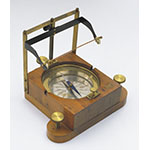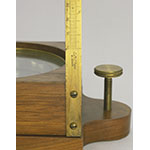Wooden base holding a magnetic compass with silvered scale; above it, secured in a brass frame, is a thick copper wire terminating in small brass screw-terminals. The rackwork is used to lower or raise the wire over the needle of the magnetic compass to examine whether the needle's deflection is influenced by its distance from the wire.
The instrument, signed by Carlo Dell'Acqua, was used by Luigi Magrini to reproduce Hans Christian Oersted's famous experiment of 1820, with which he demonstrated the action of electric current on a magnetic needle. The instrument is therefore a crude form of galvanometer. Provenance: Lorraine collections.
Provenance
Makers
Related people
Simulation
Typology
Context
Dictionary
In depth











